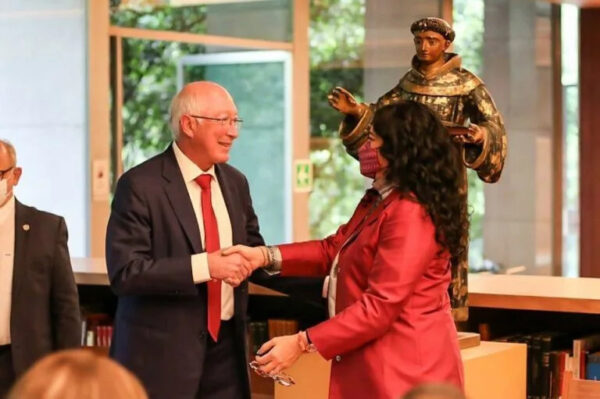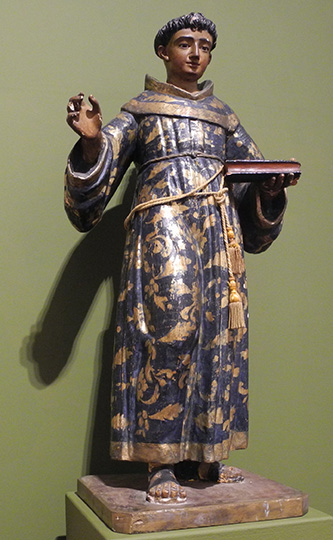Earlier this month the Embassy of the United States in Mexico and the Federal Bureau of Investigation (FBI) announced the return of a stolen 19th-century statue that had been located in the collection of the San Angelo Museum of Fine Arts (SAMFA).

U.S. Ambassador to Mexico Ken Salazar shakes hands with Alejandra Frausto, Mexico’s Secretary of Culture. COURTESY US EMBASSY IN MEXICO
The statue of Saint Anthony of Padua, the patron saint of lost things, was originally donated to the museum in 2005 by a private collector of Spanish Colonial art. According to a press release by SAMFA, “The museum was contacted by the local FBI office in 2020 after Mexican authorities matched images of the stolen sculpture on an Interpol database to a photo of the work in the museum’s collection, posted on the SAMFA website.”
Identifying this artwork is just one piece of a larger initiative launched by the Mexican government in 2018 to search for stolen art and artifacts. In the four years since it was established, the #MiPatrimonioNoSeVende (my heritage is not for sale) campaign, headed by Mexico’s Ministry of Foreign Affairs, Ministry of Culture, and National Institute of Anthropology and History, has helped the government recover nearly 9,000 items from institutions and individuals.

Unknown artist, “Saint Anthony of Padua,” c. 18th – 19th century, wood, gold leaf, paint. Image courtesy San Angelo Museum of Fine Arts
The sculpture from the SAMFA’s collection, which measures approximately 110 x 60 x 50 centimeters, is carved from solid wood and uses the estofado technique, which SAMFA describes as “where the figure is covered in gold leaf, painted over, and then the paint is scratched through to expose the gold and create an elaborate design, meant to mimic gold brocade.” The Mexican National Institute of Anthropology and History will perform restoration work on the sculpture before returning it to the church in Jiutepec, where it was originally installed.
The repatriation of the statue took place during a ceremony on August 10, where Laura Huckaby, Curator and Assistant Director of SAMFA, represented the museum. Ms. Huckaby stated, “As a museum, we are stewards and guardians, and not owners, of the works in our collection. As such, we are happy to see Saint Anthony returned to his church and his community, where he belongs. Cultural institutions like ours are in a position of trust in our communities and in the world. We want to make sure that we never abuse that trust by keeping an object that rightfully belongs somewhere else. We hope that even a small institution like ours can set an example by fulfilling our obligation.”
Ms. Huckaby told Glasstire, “Incidentally, the church the statue was stolen from was destroyed by an earthquake in 2017. It is strangely fortunate that the statue was in the museum’s care at that time, but we are thrilled to see it return home now to Mexico.”
Repatriating the sculpture was a major collaborative effort involving FBI offices in Dallas and the FBI legal attaché in Mexico City, the Department of Justice of the United States with the Ministry of Culture, the National Institute of Anthropology and History, the Attorney General’s Office, the Ministry of Foreign Exteriors, and SAMFA.
In a press release by the FBI, Dallas Special Agent in Charge Matthew J. DeSarno stated, “Along with the FBI Art Crimes team, FBI Dallas appreciates the cooperation of the San Angelo Museum of Fine Arts in assisting in the safe return of the Saint Anthony of Padua sculpture to the Government of Mexico. The FBI has developed significant relationships with our foreign partners who are committed to the protection of cultural property. We will continue to work with those partners to keep the public informed and up-to-date on arts and cultural property theft crimes to create greater awareness of stolen artifacts.”


